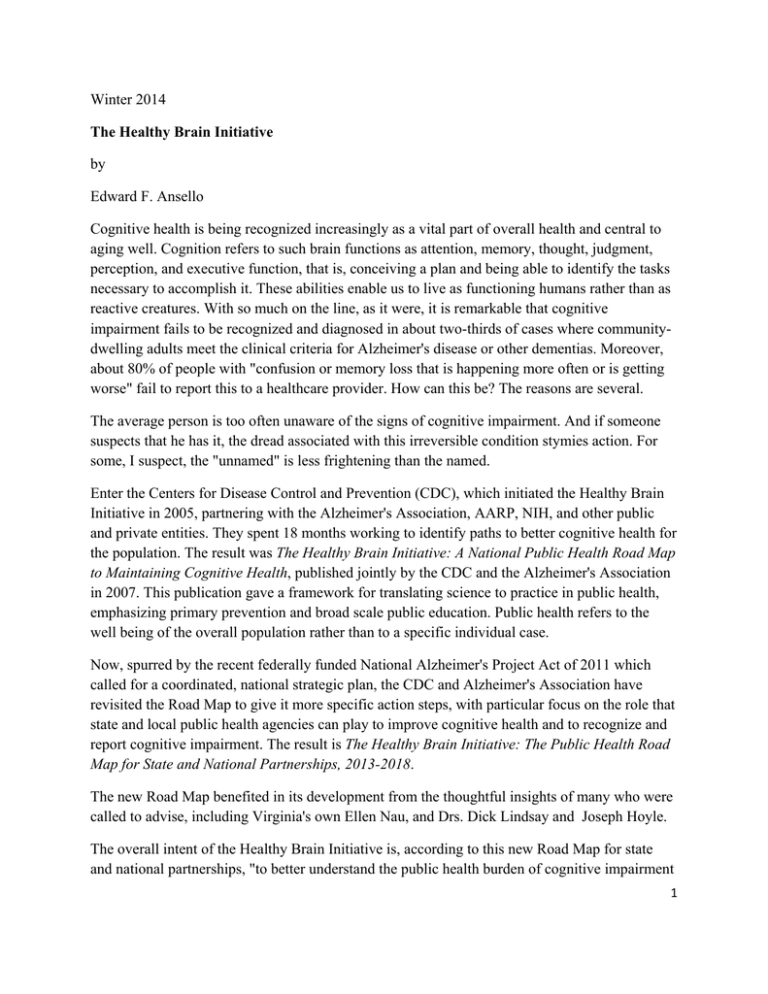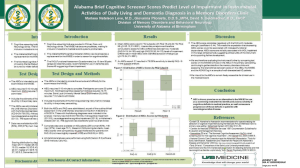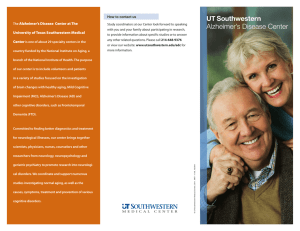Winter 2014 by Edward F. Ansello
advertisement

Winter 2014 The Healthy Brain Initiative by Edward F. Ansello Cognitive health is being recognized increasingly as a vital part of overall health and central to aging well. Cognition refers to such brain functions as attention, memory, thought, judgment, perception, and executive function, that is, conceiving a plan and being able to identify the tasks necessary to accomplish it. These abilities enable us to live as functioning humans rather than as reactive creatures. With so much on the line, as it were, it is remarkable that cognitive impairment fails to be recognized and diagnosed in about two-thirds of cases where communitydwelling adults meet the clinical criteria for Alzheimer's disease or other dementias. Moreover, about 80% of people with "confusion or memory loss that is happening more often or is getting worse" fail to report this to a healthcare provider. How can this be? The reasons are several. The average person is too often unaware of the signs of cognitive impairment. And if someone suspects that he has it, the dread associated with this irreversible condition stymies action. For some, I suspect, the "unnamed" is less frightening than the named. Enter the Centers for Disease Control and Prevention (CDC), which initiated the Healthy Brain Initiative in 2005, partnering with the Alzheimer's Association, AARP, NIH, and other public and private entities. They spent 18 months working to identify paths to better cognitive health for the population. The result was The Healthy Brain Initiative: A National Public Health Road Map to Maintaining Cognitive Health, published jointly by the CDC and the Alzheimer's Association in 2007. This publication gave a framework for translating science to practice in public health, emphasizing primary prevention and broad scale public education. Public health refers to the well being of the overall population rather than to a specific individual case. Now, spurred by the recent federally funded National Alzheimer's Project Act of 2011 which called for a coordinated, national strategic plan, the CDC and Alzheimer's Association have revisited the Road Map to give it more specific action steps, with particular focus on the role that state and local public health agencies can play to improve cognitive health and to recognize and report cognitive impairment. The result is The Healthy Brain Initiative: The Public Health Road Map for State and National Partnerships, 2013-2018. The new Road Map benefited in its development from the thoughtful insights of many who were called to advise, including Virginia's own Ellen Nau, and Drs. Dick Lindsay and Joseph Hoyle. The overall intent of the Healthy Brain Initiative is, according to this new Road Map for state and national partnerships, "to better understand the public health burden of cognitive impairment 1 through surveillance; build a strong evidence base for policy, communication, and programmatic interventions for improving cognitive health; and translate that foundation into effective public health practice in states and communities." (p. 9) At the same time, the Road Map recognizes the critical role that family caregivers have undertaken in the vast majority of situations where dementia is present. And so, the Road Map addresses caregiver burden and public health strategies to ameliorate or prevent it. This new Road Map outlines how state and local public health agencies and their partners can promote cognitive functioning, address cognitive impairment for individuals living in the community, and help meet the needs of "care partners," the document's term that acknowledges our reliance on family caregivers. The Road Map offers action steps within what the authors call the four traditional domains of public health: 1) Monitor and evaluate, 2) Educate and empower the nation, 3) Develop policy and mobilize partnerships, and 4) Assure a competent workforce. The CDC and Alzheimer's Association encourage public health agencies and private partners from the non-profit and governmental sectors across the country and within state and local levels to work together to develop steps for these four domains, as they best fit their needs, strategic plans, and capabilities. The Road Map reflects the work of committees and contributors who generated and refined suggested action steps to improve cognitive health and address cognitive impairment. This group ultimately produced 35 action steps that are spread among the four public health domains of monitoring, educating, developing policy, and building a competent workforce. Each can serve as a check list for public health, aging, disabilities, and other agencies to gauge their current state of readiness or intervention. Virginia has already accomplished several of these actions; how does your jurisdiction fare? Because of space limitations, we will list just a few under each domain. The web address to access the full 58-page Road Map is at the end. Monitor. There are 13 action steps that seek to help us Monitor and Evaluate cognitive health and cognitive impairment. (Surveillance refers to on-going collection and analysis of populationlevel health-related data.) These include: -Implement the Behavioral Risk Factor Surveillance System’s cognitive impairment and caregiver modules (a standardized national survey to which individual states may add a limited number of questions). -Use surveillance data to enhance awareness and action in public health programming (e.g., link Behavioral Risk Factor Surveillance System questions on cognition to health-related quality of life or falls prevention). 2 -Define the needs of caregivers and persons with dementia, including Alzheimer’s disease and younger onset, as they relate to employment and employers. -Examine the Chronic Disease Self-Management Program and other evidence-based programs to determine their ability to include persons with dementia and their care partners. Educate. There are 10 actions intended to Educate and Empower the Nation. These include: -Identify and promote culturally appropriate strategies designed to increase public awareness about dementia, including Alzheimer’s disease, to reduce conflicting messages, decrease stigma, and promote early diagnosis. -Develop strategies to promote the availability of services for people with younger-onset dementia, including Alzheimer’s disease. -Promote awareness of abuse and exploitation and support related prevention efforts as they relate to persons with dementia, including Alzheimer’s disease. -Promote advance care planning and advance financial planning to care partners, families, and individuals with dementia in the early stages before function declines. Policy. There are five action steps to Develop Policy and Mobilize Partnerships, including: -Collaborate in the development, implementation, and maintenance of state Alzheimer’s disease plans. -Integrate cognitive health and impairment into state and local government plans (e.g., aging, coordinated chronic disease, emergency preparedness, falls, and transportation plans) Workforce. The Road Map suggests seven action to Assure a Competent Workforce to strengthen cognitive health and confront (identify and treat) cognitive impairment. These include: -Support continuing education efforts that improve healthcare providers’ ability to recognize early signs of dementia, including Alzheimer’s disease, and to offer counseling to individuals and their care partners -Develop strategies to help ensure that healthcare professionals recognize the role of care partners in the care coordination of persons with dementia, including Alzheimer’s disease. -Educate healthcare providers about validated cognitive assessment tools that could be administered in such settings as physicians’ offices, clinics, emergency rooms, and acute care hospitals’ admission offices. -Increase awareness among healthcare professionals about care partner health. 3 As with all road maps or blueprints, local or regional characteristics and histories may alter which actions are undertaken and when. It is in our own self-interest and the interests of those we care about, that some actions be started. This is the only way that the feared and the unnamed can become the known and treated. To access a copy of this new Road Map, go to: http://www.cdc.gov/aging/healthybrain/roadmap.htm 4






